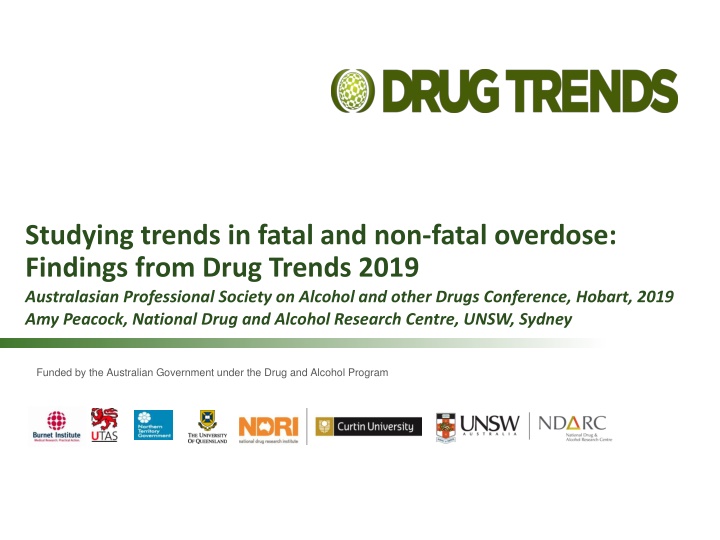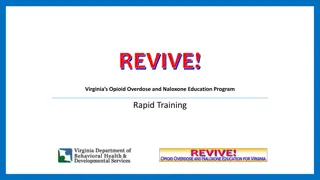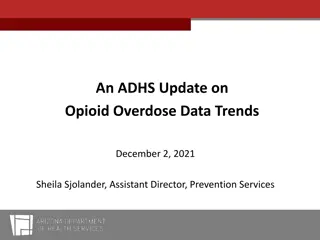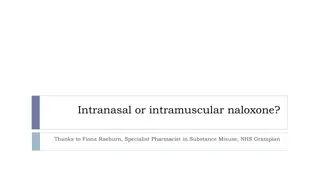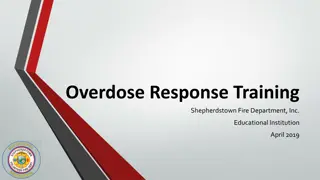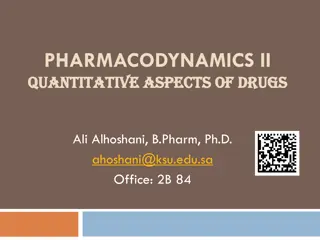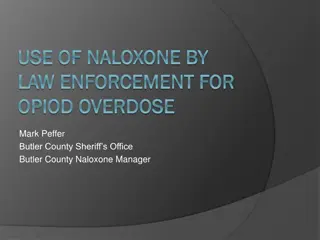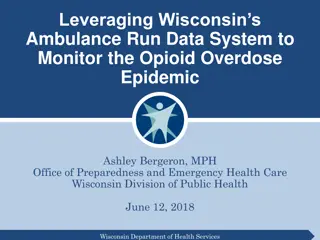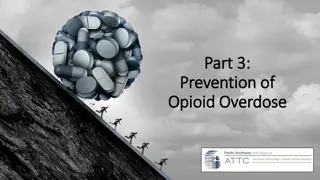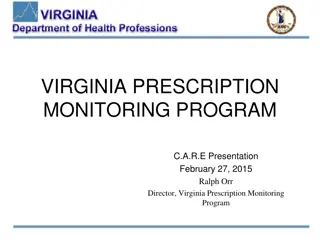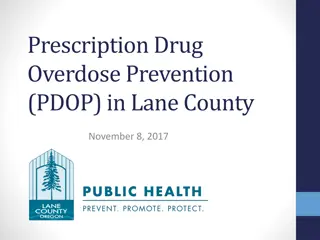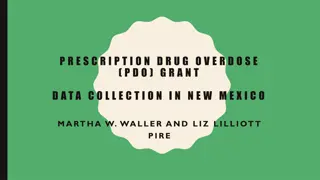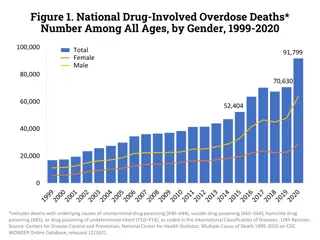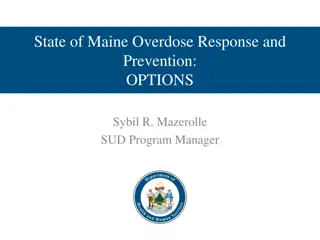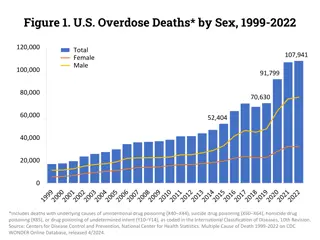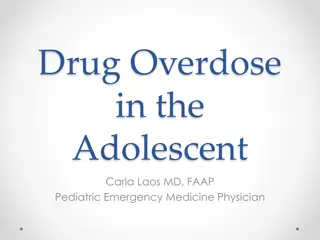Trends in Fatal and Non-Fatal Overdose: Drug Trends 2019 Conference Findings
Studying trends in fatal and non-fatal overdose at the Australasian Professional Society on Alcohol and other Drugs Conference in 2019, Amy Peacock presented findings funded by the Australian Government. The research involved analyzing data sources like cryptomarket data, mortality data, hospitalization data, and more to monitor trends in illicit drug use, harms, and markets. Various stakeholders contribute to establishing analytical reports and priority research questions.
Download Presentation

Please find below an Image/Link to download the presentation.
The content on the website is provided AS IS for your information and personal use only. It may not be sold, licensed, or shared on other websites without obtaining consent from the author.If you encounter any issues during the download, it is possible that the publisher has removed the file from their server.
You are allowed to download the files provided on this website for personal or commercial use, subject to the condition that they are used lawfully. All files are the property of their respective owners.
The content on the website is provided AS IS for your information and personal use only. It may not be sold, licensed, or shared on other websites without obtaining consent from the author.
E N D
Presentation Transcript
Studying trends in fatal and non-fatal overdose: Findings from Drug Trends 2019 Australasian Professional Society on Alcohol and other Drugs Conference, Hobart, 2019 Amy Peacock, National Drug and Alcohol Research Centre, UNSW, Sydney Funded by the Australian Government under the Drug and Alcohol Program
Acknowledgements Funding: Australian Government Department of Health Drug Trends Team: National Drug and Alcohol Research Centre: Nicola Man, Agata Chrzanowska, Antonia Karlsson, Julia Uporova, Daisy Gibbs, Rosie Swanton, Olivia Price, Louisa Degenhardt, Michael Farrell Burnet Institute: Amy Kirwan, Cristal Hall, Campbell Aitken, Paul Dietze School of Medicine, University of Tasmania: Callula Sharman and Raimondo Bruno National Drug Research Institute: James Fetherston, Jodie Griggs, Seraina Agramunt, Simon Lenton Institute for Social Science Research, The University of Queensland (QLD): Catherine Daly, Leith Morris, Caroline Salom Northern Territory Department of Health: Chris Moon Other Acknowledgements: IDRS participants and data custodians (including the Australian Bureau of Statistics) Conflicts of interest: Amy Peacock: untied educational grant from Mundipharma and Seqirus for study of opioid medications Raimondo Bruno: untied educational grant from Mundipharma and Indivior for study of opioid medications Louisa Degenhardt: untied educational grant from Mundipharma, Seqirus and Indivior for study of opioid medications Michael Farrell: untied educational grant from Mundipharma, Seqirus and Indivior for study of opioid medications Paul Dietze: untied educational grant from Gilead Sciences for HCV research and untied educational grant from Indivior
To establish, maintain, and continuously improve monitoring of trends in illicit drug use, harms, and markets across Australia AIM National Monitoring: Secondary Data Jurisdictional Monitoring: Secondary Data Sentinel Sample Monitoring Online Monitoring DATA SOURCES Cryptomarket Data Scraping listings on darknet drug markets Illicit Drug Reporting System (IDRS) Ecstasy and Related Drug Reporting System (EDRS) Annual interviews with people who inject drugs (IDRS) and who use stimulants (EDRS) Mortality Data Drug-induced deaths from registry and coronial data Hospitalisation Data Drug-induced hospitalisations Other Sources Household survey, treatment data etc Various sources assessing drug use and harms at the population-level (e.g., emergency department presentations) and subpopulation level (e.g., needle-syringe program visits) OUTPUT Input from researchers, national stakeholders, and jurisdiction stakeholders to inform priority research questions Analytical reports
To establish, maintain, and continuously improve monitoring of trends in illicit drug use, harms, and markets across Australia AIM National Monitoring: Secondary Data ABS undertakes a revision process over a 3-year period; estimates for 2016, 2017, and 2018 are preliminary. Jurisdictional Monitoring: Secondary Data Caveats Sentinel Sample Monitoring Online Monitoring DATA SOURCES Cryptomarket Data Scraping listings on darknet drug markets Illicit Drug Reporting System (IDRS) Ecstasy and Related Drug Reporting System (EDRS) Annual interviews with people who inject drugs (IDRS) and who use stimulants (EDRS) Mortality Data Drug-induced deaths from registry and coronial data Hospitalisation Data Drug-induced hospitalisations Other Sources Household survey, treatment data etc Does not include deaths caused by alcohol or tobacco. Various sources assessing drug use and harms at the population-level (e.g., emergency department presentations) and subpopulation level (e.g., needle-syringe program visits) The codes applied to identify cause of death have limited specificity for drugs. Number of deaths may differ between organisations reporting on deaths due to codes used. Small numbers are randomised to protect confidentiality. OUTPUT Input from researchers, national stakeholders, and jurisdiction stakeholders to inform priority research questions Analytical reports
Drug-induced deaths in Australia, all ages, 1997- 2018 Preliminary estimate of 1,740 drug- induced deaths in 2018 (1,210 deemed accidental) 35.7% increase in number of deaths
Accidental drug-induced deaths in Australia, all- ages, 1997-2018 Drugs involved in deaths, 2018 Opioids Per 100,000 people Cases 904 3.62 Antiepileptic, sedative- hynpnotic Antidepress. 698 2.79 373 1.49 Amphetamines Antipsychotics/ neuroleptics 365 1.46 261 1.04 Cannabis 240 0.96 Alcohol 238 0.95 Non-opioid analgesics Cocaine 201 0.80 54 0.22
Accidental opioid-induced deaths in Australia by opioid type, all ages, 1997-2018
Accidental opioid-induced deaths in Australia by opioid type, 15-64 age group, 1997-2018
Naloxone knowledge and training in a national sample of people who inject drugs (Illicit Drug Reporting System) 100 87 86 86 86 90 85 85 85 Heard of naloxone 80 70 % of IDRS Participants Heard of take- home programs 58 57 60 53 52 49 50 43 40 35 Trained in naloxone administration 32 32 30 26 30 20 23 Heard of naloxone rescheduling 18 17 10 13 12 7 0
Naloxone knowledge and training in a national sample of people who inject drugs (Illicit Drug Reporting System) Have you been trained in naloxone administration? 15% reported past 12-month opioid overdose 4% had been resuscitated by someone who had participated in a take- home naloxone program 19% 27% 33% 8% 40% 47% ACT: 45% who had participated in a training program had used naloxone to reverse overdose 51% <5%
Preventing overdose: food for thought Non-fatal overdose can lead to significant harms (e.g., brain injury). For discussion: what are the effective strategies for preventing any overdose? Naloxone IDRS 2019 Opioid pharmacotherapy (access, coverage, and retention) Supervised consumption facilities Overdose education 1 in 10 people who inject drugs had ever tested their drugs (11%; 6% in the past year) Drug checking services (+ information- sharing) Peacock et al. (2019)
Preventing overdose: food for thought Non-fatal overdose can lead to significant harms (e.g., brain injury). For discussion: what are the effective strategies for preventing any overdose? Naloxone Opioid pharmacotherapy (access, coverage, and retention) Supervised consumption facilities Overdose education Drug checking services (+ information- sharing) Wearable overdose detection technology Others? And things we know don t work?
For further information 2018 deaths data published late Nov/early Dec 2019 Contact us drugtrends@unsw.edu.au Subscribe to our newsletter https://tinyurl.com/y8g5y7t9 Download our reports https://ndarc.med.unsw.edu.au/pr ogram/drug-trends Go to our website https://ndarc.med.unsw.edu.au/pro gram/drug-trends Check out our interactive visualisation https://drugtrends.shinyapps.io @NDARCNEWS #DrugTrends @ndarcunsw 13
